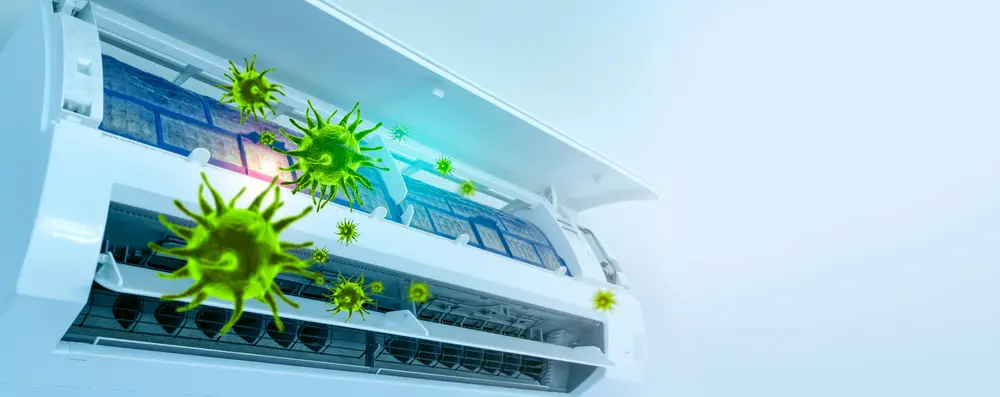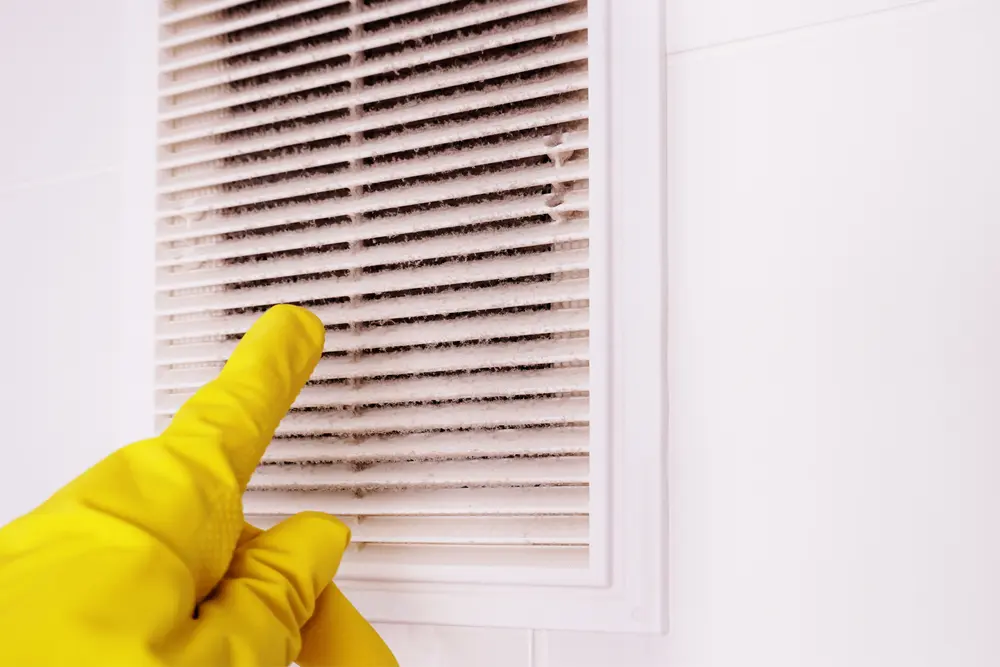The health of your home is dependent on a variety of factors. One of the most important pieces of that puzzle is indoor air quality. HVAC systems shouldn’t be forgotten when it comes to keeping your home’s air clean and healthy. One of the best ways to boost your home’s indoor air quality is installing UV lights for the HVAC system.
Chapman Heating, Air Conditioning, Plumbing & Electrical is here to help you learn about the positive impacts installing UV lights for an HVAC system can have on your home’s indoor air quality.
What is a UV Light for an HVAC System?
UV lights for HVAC systems are lights to help clean and purify indoor air. These lights are installed in the air handler or ductwork of an HVAC system. The circulating air within a home carries germs and allergens and once it’s passed through the UV light, the air is sanitized and recirculated, boosting indoor air quality.
How Germicidal UV Lights Kill Viruses and Bacteria
Germicidal UV lights for HVAC systems create a powerful illumination capable of destroying bacteria, viruses, mold, and other airborne pathogens. Through the destruction of their DNA, they are no longer able to replicate or are simply eliminated instantly.
These lights are commonly utilized across residential and commercial settings. UV lights have long been used to treat issues like tuberculosis. Turn to Chapman for all of your air purification needs, such as air purification systems.
Reduce Bacteria & Allergens – Get UV Light Protection!
Types of UV Lights for HVAC Systems
Different types of UV lights for HVAC systems are designed for numerous purposes. Let’s look at two types of UV lights and how they work.
Air Sanitizing UV Lights. Installed within the ductwork or air handler, UV light sanitizers or air sanitizing UV lights treat the air as it’s circulated through the system. By killing airborne microorganisms and cutting down on the number of contaminants, indoor air quality sees a healthy improvement.
Coil Sanitizing UV Lights. UV light sanitizers of this variety are installed near the indoor evaporator coil of an air conditioning system. These lights are an excellent combatant to mold growth and bacteria surrounding the coil due to accumulating moisture. The UV lights can shine directly on the coil, preventing contaminants and keeping it clean.
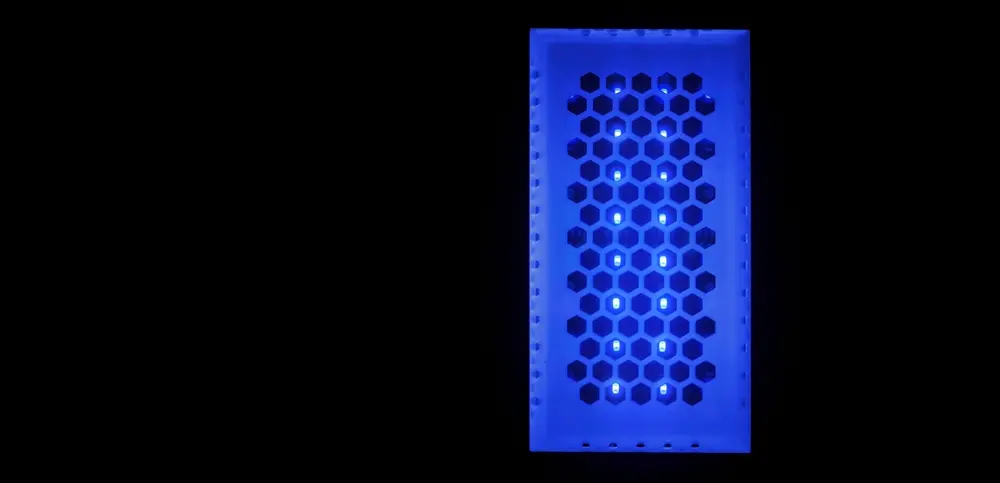
Pros and Cons of Installing a UV Light for Your HVAC System
Before committing to a purchase, there are pros and cons of UV lights in HVAC systems to consider. Let’s walk through the pros and cons so you can make a smart and informed decision.
Pros
Improved Air Quality
With the elimination or reduction of germs, allergens, and other harmful airborne contaminants, the air of your home is safer and healthier. The improvement of indoor air quality helps maintain the health of your household.
Odor Control
Volatile organic compounds (VOCs) are known for leaving behind unpleasant odors. UV lights for HVAC systems can reduce VOCs, acting as a means of odor control.
Improved Airflow
UV lights improve indoor air quality by removing bacteria, mildew, and other particles. They also improve airflow. You can expect your system’s airflow to be as clean and efficient as ever before.
Extended HVAC Lifespan
By installing air-sanitizing UV lights and coil-sanitizing UV lights, the indoor evaporator coil and ductwork of the HVAC system stay clean. This prevents component damage, corrosion, or clogging, keeping the HVAC system free of issues—further extending its lifespan. An extended HVAC lifespan means less money spent on repairs and replacements, putting more money back into your pockets.
Reduced Allergens
The presence of allergens in your home can lead to flares in allergies and other illnesses. UV lights effectively treat and reduce allergens as they pass through the HVAC system.
Low Maintenance
UV lights for HVAC systems are known for their minimal upkeep. The most they require is an occasional bulb replacement. This convenient benefit makes for a dependable long-term option for the improvement of your home’s indoor air quality.
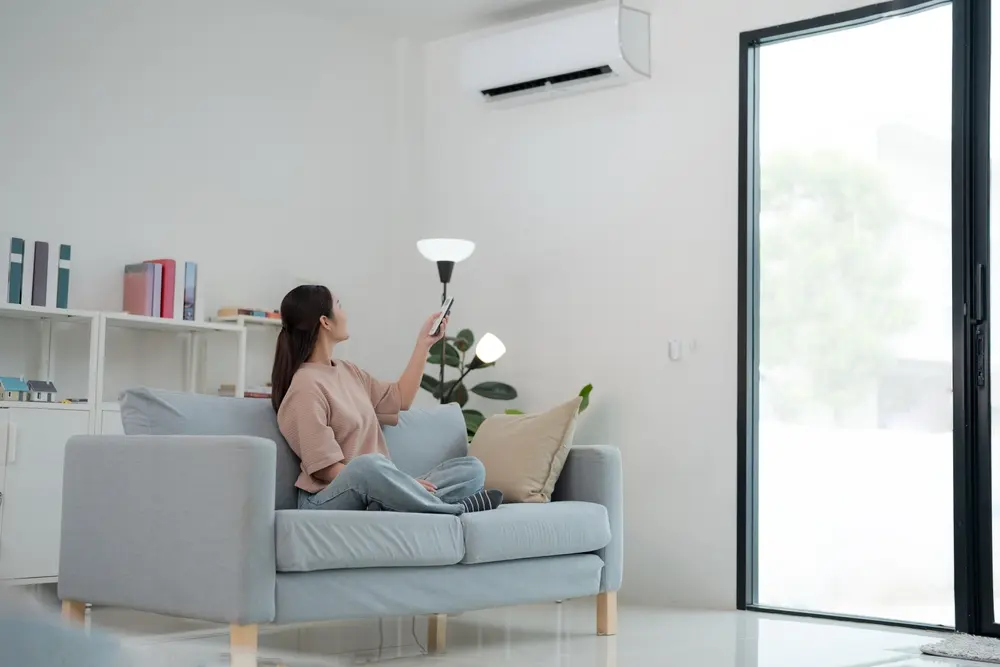
Cons
High Upfront Installation Costs
HVAC UV light installation tends to run on the more expensive side. One light can cost between $100 and $1,000. In addition, proper and professional installation is required.
Limited Effectiveness
The effectiveness of UV lights is only limited to what passes through its beams. Dust particles, bacteria, and other contaminants that don’t pass through the light will be missed.
Potential Safety Concerns
It’s important to avoid looking at or touching the UV lamp when it’s on. Exposure to UV rays is a safety concern due to its potential to damage the eyes and skin.
Ozone, a possible byproduct, can also irritate the lungs and worsen respiratory issues. If UV lights for your HVAC system need to be replaced or cleaned, wear the proper protective equipment or call a professional.
Not a Substitute for Proper Air Filtration
HVAC UV light installation isn’t a substitute for filters and other HVAC systems. If you utilize UV lights for HVAC systems, keep all filters and other HVAC systems in place to remove dust and particles the lights can’t reach.
Are UV Lights the Right Choice for Your Home’s HVAC System?
While UV lights for HVAC systems can’t eliminate every particle within a home, they are still helpful and worthwhile investments for any homeowner looking to improve their indoor air quality.
For comprehensive HVAC Sanitizing & HVAC UV Light Installation services, turn to the certified HVAC technicians at Chapman Heating, Air Conditioning, Plumbing & Electrical.
Improve Your Indoor Air Quality – Schedule Now!
Keeping the air in your home of the highest quality is a big responsibility. One area is your home’s air ducts, which play an integral role in indoor air quality. Bacteria, allergens, and other airborne contaminants can lead to a decrease in your home’s air quality, which isn’t great for your quality of living. A treatment option to address these concerns is air duct sanitizing.
The experts at Chapman Heating, Air Conditioning, Plumbing & Electrical are here to help you understand the ins and outs of air duct sanitizing and disinfecting and its importance.
Understanding the Differences Between Air Duct Sanitizing, Cleaning, & Disinfecting
While air duct cleaning and air duct sanitizing are important on their own, they do serve different purposes.
What is Air Duct Cleaning?
Air duct cleaning is a process that removes dust and debris from air ducts. Air duct cleaning services typically utilize powerful vacuums to suck out dirt, grime, and other debris to clean and clear the air ducts.
What is Air Duct Sanitizing?
Air duct sanitizing is a chemical-based process aimed at killing the presence of bacteria and mold within the air ducts. Mold growth and bacteria in your air ducts can potentially cause and spread illness. Air duct sanitizing is part of the solution to keep the home healthy and to prevent this possibility. Air duct sanitizing and disinfecting refer to the same air purification service.
Air duct cleaning does improve indoor air quality, but it isn’t the primary solution. A routine schedule of air duct sanitizing for your home keeps the development of mold and bacteria within the air ducts at bay.
Is Sanitizing Air Ducts Necessary?
Yes, it is. Sanitizing your home’s air ducts is an essential component of addressing the growth of mold and even a vermin infestation. Without air duct sanitizing, the potential for mold growth, infestation, and a decline in your home’s indoor air quality becomes more likely.
Protect Your Home from Mold & Vermin with Regular Air Duct Sanitization
When it comes to mold, spores are attracted to areas of previous growth and will stick there. The products used during air duct sanitizing effectively kill mold spores and are an excellent deterrent to preventing them from growing in previously affected areas.
Occurrences of a vermin infestation aren’t easy to tackle. Thankfully, air duct sanitizing can help make the process easier. Unlike standard air duct cleaning, air duct sanitizing can effectively remove animal scents and territorial markings. This makes the possibility of a reinfestation far less likely to occur in that area.
When Should You Sanitize and Disinfect Your Air Ducts?
The general guideline for homeowners to follow is scheduling air duct sanitizing every two to three years. However, there is no downside to reducing the amount of time between services. It’s also important to keep in mind your air ducts need to be free of dust and debris before sanitization.
By following these recommendations, you can prevent mold and bacteria from building in your air ducts while maintaining healthy indoor air quality.
Schedule Your Air Duct Sanitizing Today!
Common Reasons & Signs You Should Schedule HVAC Duct Cleaning
As a homeowner, how do you know when it’s time to schedule an air duct cleaning? Here are some common indicators it’s time to schedule your next air duct cleaning service:
- Your home gets dusty fast
- Heating and cooling costs are higher than normal
- You recently moved into a new or pre-owned home
- The airflow in your home is inconsistent
- You’ve noticed unpleasant odors coming from your air ducts
- Your home just underwent a remodeling project
- Mold and mildew are growing in the air ducts
Scheduling an air duct cleaning for your home should be conducted more frequently if you own pets, have allergies, or if there’s a ton of dust or recent construction projects surrounding your home.
Is Air Duct Sanitizing Safe?
Air duct sanitizing is indeed safe when it’s performed by qualified professionals. Professional air duct cleaners like our team at Chapman only utilize EPA-registered disinfectants to sanitize your air ducts. These disinfectants are specifically designed for HVAC systems.
At Chapman, we also take all of the necessary precautions to protect your home. From using cloths to catch debris during service to wearing shoe covers, rest assured the condition of your home won't be affected.
If you have any questions about the disinfectants we use or how our process works, we’re more than happy to discuss it with you.
Improve Your Indoor Air Quality With Professional HVAC Sanitizing
For HVAC sanitizing services you can rely on to improve your home’s indoor air quality, choose Chapman. We’re ready to help homeowners in Indianapolis and other areas of the Central Indiana region keep their homes healthy and clean. The same level of care can be seen with our furnace duct cleaning and AC cleaning services.
Improve Your Indoor Air Quality – Book Now!
Indiana residents are all too familiar with frigid winters. During those months, HVAC systems work harder to keep homes warm and families comfortable. Because of the increased workload put on HVAC systems during this period, these systems are more likely to become damaged and potentially break down.
Chapman Heating, Air Conditioning, Plumbing & Electrical is here to provide you with winter HVAC tips to better prevent that from happening. Just follow the tips below to ensure a functional HVAC system all winter long.
Why is Preventative HVAC Maintenance Important?
Preventive HVAC maintenance is important because it keeps your HVAC system in good working order. Benefits as a result of preventive maintenance not only includes comfort, it also reduces the need for costly repairs and lowers your energy bills. saving you money and conserving energy. With the possibility of a system breakdown during the winter, preventative maintenance goes a long way to help mitigate that possibility.
HVAC Maintenance Tips for Indiana Winters
To keep your Indiana HVAC system better prepared for the winter, start by putting these tips into practice:
- Clear all registers and vents. Start by making sure all registers and vents in your home are clean and free of obstructions. Furniture and rugs often cover or block these vents. Blocked or clogged air vents prevent air from circulating properly throughout your home. Thus, making it harder to warm your home.
- Replace your air filter. Harsh winters or not, clean air filters are a key component of a functioning HVAC system. Because of the increased workload on your HVAC system during the winter, air filters become dirty and clogged at a faster rate. If your air filters are reusable, you should regularly inspect them to make sure they are clean. For non-reusable air filters, change them monthly for optimal HVAC performance.
- Set your thermostat for energy efficiency. To boost the energy efficiency of your home, setting your thermostat for certain situations is a great way to do that. Some suggestions include not putting your thermostat above 70 degrees while you’re home and keeping the temperature between 60 and 62 degrees while you’re sleeping. Also, avoid overriding your thermostat’s pre-programmed settings and resort to a blanket instead of adjusting the temperature.
- Seal ductwork. Sealing your home’s ductwork prevents large amounts of wasted energy. You’re going to need the best performance out of your HVAC system during the winter. That’s why sealing your home’s ductwork is helpful.
- Listen for any strange noises. The presence of new and unpleasant sounds or smells coming from your HVAC system is never a good sign. This often indicates your HVAC system is struggling to fulfill its duties. This normally means the furnace is dirty or in need of repairs.
- Test the thermostat & heating unit. About a month before the winter season comes around, test your thermostat and heating unit. Cycle through the thermostat’s functions and make sure it’s responding correctly and set the heat to a specific temperature to make sure heating isn’t an issue. This will give you an idea of the current state of these components and if any repairs are needed before winter comes around.
- Ensure your home is properly insulated. One of the biggest factors to help keep your home comfortable during the winter months is insulation. Insulation can help prevent the loss of heat and keep it within your home, maintaining desired temperatures and increasing energy efficiency. Make sure areas like the attic, roof, and gaps around doors and windows are properly insulated. These areas in particular are the main culprits of lost heat.
- Schedule an HVAC system inspection. Get in the habit of scheduling an annual HVAC inspection in the fall. Scheduling one in the fall helps mitigate the possibility of a system breakdown during the coldest months of the year. These inspections also keep your system in working order and help diagnose possible issues as they arise.
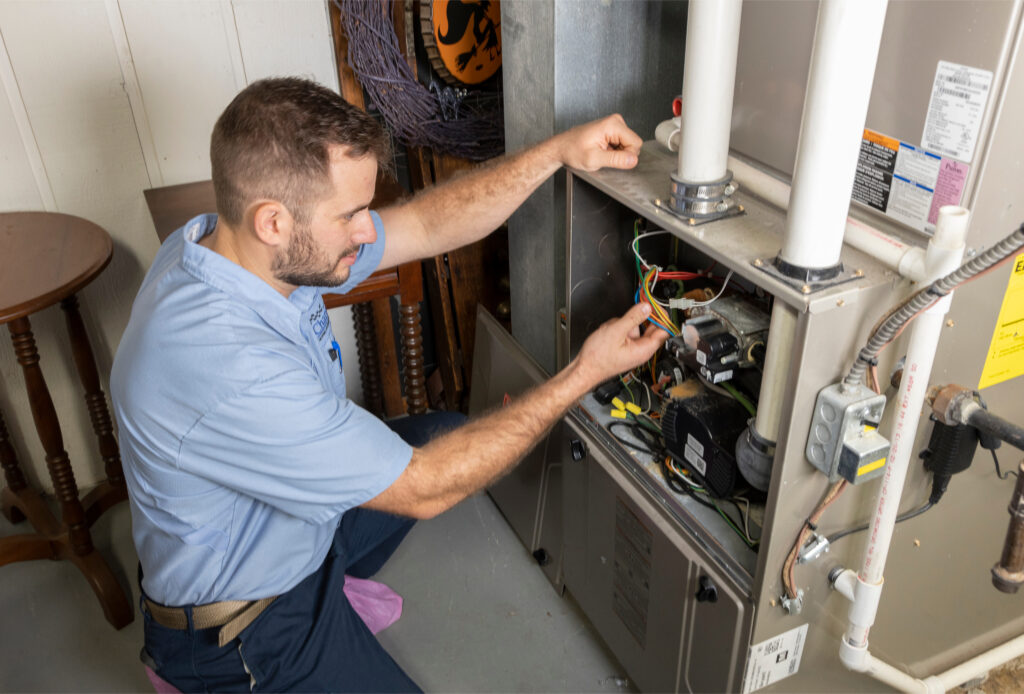
Importance of a Pre-Winter Furnace Tune-Up
A pre-winter furnace tune-up is important for these reasons:
Decrease Risk of Breakdowns
Scheduling a tune-up for your furnace in the fall helps decrease the risk of a breakdown. No one wants to wake up in the middle of the night only to realize their home is an icebox.
Lower Your Energy Bills
A furnace tune-up in the fall makes sure it’s clean, oiled, and ready to deliver the best results. In turn, lowering energy bills without sacrificing comfort.
Boost Indoor Air Quality
Winter happens to be a season with heightened chances for carbon monoxide poisoning. Neglected furnaces are often the cause. Furnace tune-ups check for gas leaks, assess CO levels, and take other steps to boost the indoor air quality of your home. A win-win situation across the board.
Extend the Life of Your Furnace
Furnaces commonly last in between the 10 to 15-year range. But, furnaces that aren’t given the proper maintenance often fail sooner. Routine maintenance brings about reliable performance, no matter the season. On top of that, adding years to your system’s lifespan.
Reduce Your Repair Costs
Tune-ups catch developing problems early, giving attention to issues before they can lead to mid-season breakdowns and costly repairs. Regular maintenance is a much more affordable option compared to repairs that will make a serious dent in your wallet.
Prepare Your Home with Our Winter HVAC Maintenance Service
Better prepare your home with our comprehensive winter HVAC maintenance services. Whether you need heating, furnace, or heat pump maintenance services, our expert technicians are ready to help today in areas surrounding Indianapolis like Carmel, Fishers, Lebanon, Pittsboro, and more.
Wondering why your AC unit is freezing up in the hottest months of the year? You might ask yourself, “How is it that it’s 90 degrees outside and my AC unit has frost buildup?” This issue actually happens to be a very common problem and can lead to further HVAC complications.
So, why is your AC unit freezing up? And, what can you do to prevent this from happening? It’s important to understand the causes and preventive measures to tackle this common air conditioning issue.
What Causes an AC Unit to Freeze Up?
Low AC Refrigerant
Your AC unit requires a certain amount of refrigerant to guarantee the best cooling performance. When the refrigerant falls under the required amount, the balance will be thrown off and lead to your air conditioner freezing.
If you spot frozen coils, this is a common sign your air conditioner has low refrigerant levels. Contact a professional technician to restore your air conditioner’s refrigerant levels and mitigate the possibility of future AC problems.
Dirty Air Filters
One of the most common factors that leads to your AC freezing up is a dirty air filter. Your air conditioner’s air filter can become dirty due to debris buildup and dirt accumulation. This will then lead to a lack of airflow into your AC system and cause it to overwork itself, resulting in a freeze. Monitor your air filters and change them regularly to avoid a frozen AC unit.
Broken or Clogged Coils
A broken or clogged evaporator coil can also lead to a frozen AC unit. Evaporator coils may become clogged due to dirt and dust buildup or they can become corroded over time and break and lack efficiency. These issues compound and lead to unusual temperatures, leading to ice buildup.
Blocked Air Vents
A blocked air vent is caused by the same debris and dirt buildup seen with dirty air filters. The same cause leads to the result, a frozen AC unit. Check your air vents regularly and clean and vacuum them when necessary.
Damaged Blower Motor
The blower motor in your air conditioning system plays a key role in keeping your home cool. If the blower motor becomes damaged or fails altogether, this can cause your AC unit to freeze and cease working. Hearing a rattling sound while it’s trying to operate indicates something is wrong with it. Issues with a blower motor are a more complex issue and an HVAC technician should be consulted if the blower motor is the culprit.
Clogged Condensate Drain Line
Your AC’s condensate drain line is responsible for removing water created in the cooling system and disposing it away from your home. The condensate drain line can become clogged due to dirt, mold, or debris and the created excess moisture can flow into your AC unit and home, possibly causing issues to both. And ultimately, freeze your air conditioning coils.
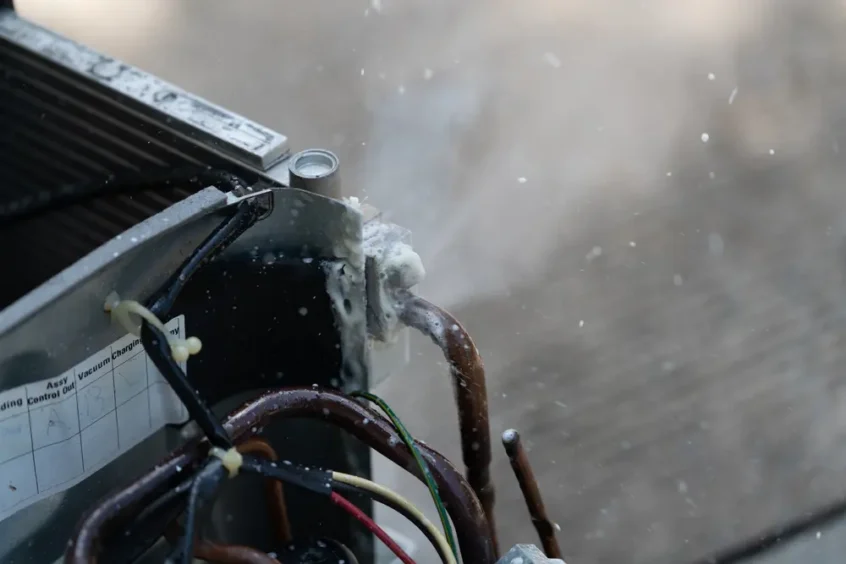
How to Stop Your Air Conditioner From Freezing Up
Now that the causes of this problem have been established, what are the ways to prevent a frozen AC unit? Use these tips as an added layer of protection against freeze buildup.
1. Check Refrigerant Levels
Have an HVAC technician inspect your refrigerant levels to determine if your AC unit needs or is sufficient for the time being.
2. Replace Your Air Filter
You should practice regularly checking your AC’s air filters. Inspect the air conditioner’s air filters for debris or dirt buildup and clean or replace them every one to two months. This will improve your air conditioner’s performance and the quality of air. Replacing a dirty or clogged air filter can lower your air conditioner’s energy consumption by 5% to 15%.
3. Inspect the AC Drain Line
It’s important to check your AC drain line throughout the summer, but using a dry/wet shop vacuum to remove debris and other buildup will help you prevent a frozen AC unit. You can also turn to an HVAC specialist to help with this preventive measure.
4. Keep Vents Open
Keeping your vents open and free of blockages is one of the easiest ways to prevent a frozen AC unit. Avoid closing more than two or three vents at any given time.
5. Contact an HVAC Technician to Inspect Your Fan
Your blower motor’s fan is a vital piece of equipment to help generate airflow. This is often difficult to do on your own, so contact an HVAC technician to inspect your fan. Keeping the blower motor’s fan in working order is an important step to prevent a frozen AC unit.
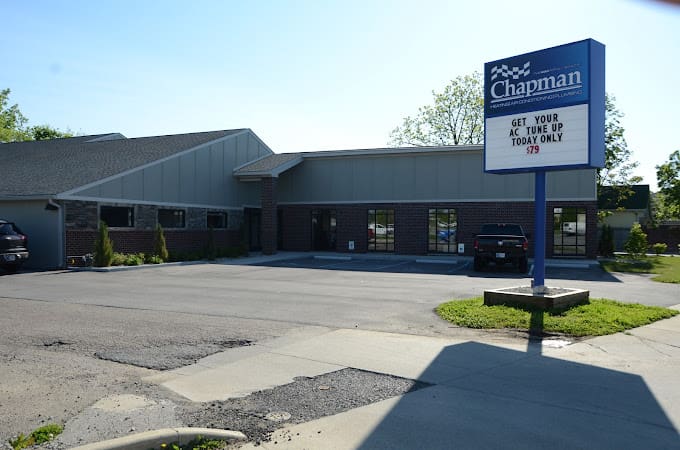
Serving Carmel, Fishers, Lawrence, and Nearby Cities with Reliable Air Conditioning Services
A frozen AC unit at your home can stem from a variety of causes, but thankfully, there’s a great list of preventative measures to help you start preventing it from happening. If your options have run out and you’re stuck with a frozen AC unit in the Indianapolis, Indiana, area, Chapman Heating, Air Conditioning, Plumbing & Electrical is ready to help.
Chapman Heating, Air Conditioning, Plumbing & Electrical provides reliable and efficient air conditioning services for homes in Indianapolis, Carmel, Fishers, Lawrence, and other surrounding areas. Chapman’s HVAC technicians are there to keep your household cool all summer long.
Your home's air conditioner holds significant importance among its appliances. A malfunctioning unit can cause considerable inconvenience for homeowners. AC capacitors play a crucial role in the functioning of any Indianapolis HVAC air conditioning system, and a deteriorating capacitor can precipitate AC problems.
What Is an Air Conditioning Capacitor?
An AC capacitor is a piece of equipment inside the outdoor condensing unit of an air conditioner. The AC capacitor delivers power to the motor driving the air conditioning system. The capacitor jumpstarts the cooling cycle by providing a surge of energy to the system. It then sustains operation by supplying consistent electricity until the cycle finishes. Initially, it delivers a power surge equivalent to 300 to 500 percent of the system's normal electrical requirement.
Once the air conditioner motor reaches its optimal speed, the capacitor regulates excess power and provides a stable energy supply throughout the cooling process. Much like a battery, the AC capacitor is similar to a battery, storing and distributing energy as needed during operation.
How Long Does an Air Conditioning Capacitor Last?
No homeowner wants to deal with ac issues, especially during the summer months. With the AC capacitor being the air conditioning unit’s main component, a fully functioning AC capacitor is a necessary item to avoid uncomfortable living conditions. AC capacitors can last a long time but will need to be replaced down the road.
With routine maintenance on your Indianapolis air conditioning unit, an AC capacitor can last up to 20 years. To avoid any issues, scheduling regular maintenance with a professional can make a world of difference. Following up on this advice will contribute to the longevity of your AC capacitor and your air conditioning unit as a whole.
7 Signs of a Bad AC Capacitor
Being able to tell the signs of a faulty AC capacitor is a key first step to diagnosing possible AC issues. Here are seven signs to tell if your AC capacitor is bad.
1. Air Conditioner Blowing Warm Air
When your air conditioner is running but is failing to blow cold air throughout your home, it could be a faulty AC capacitor. This symptom is insinuated by the air conditioning unit blowing out warm air. When the AC capacitor is bad, it prevents itself from starting and the air conditioner is no longer able to remove heat and transfer it outside the home.
2. Humming Noise
Another sign of a faulty AC capacitor is a humming noise coming from the access panel of the condenser unit. This will force the capacitor to operate at an excessive level, resulting in that mentioned humming noise.
This sound might also originate from the AC motor. To differentiate the noise, try turning the AC unit on and off. If the humming persists, it’s likely stemming from the AC capacitor.

3. Burning Smell
A particularly worrisome sign for a homeowner is a burning smell coming from the condenser unit. This smell usually signifies a faulty AC capacitor. This may be due to item obstruction, normal wear and tear for the system, or even overexertion. You might be able to fix it by lubricating the bearings, but replacement will be a better option for a long-term solution.
4. High Energy Bills
If your capacitor is damaged, it will cause the compressor to overwork itself. When components within the air conditioning system are run excessively, this can lead to higher energy bills. Identifying symptoms like high energy bills and getting repairs will prevent costs from compounding on top of each other. Having to pay higher energy bills and repairs is a nuisance that nobody wants to deal with.
5. Air Conditioner Turns Off
One of the many signs of a bad capacitor is the air conditioner turning off suddenly. The air conditioning system should never shut off on its own. It’s common for the unit to short circuit now and then, but continuous issues with your air conditioner need to be evaluated for a permanent fix.
6. Air Conditioner Won’t Turn On
Setting your thermostat to your desired temperature and the air conditioner refusing to turn on is an issue no homeowner wants to face. One of the issues that could cause this is a bad AC capacitor. If the AC capacitor is indeed bad, the air conditioner may take longer to turn on or won’t turn on at all. Severe damage to the AC capacitor may cause the air conditioner to not turn on period.
7. Aging HVAC System
The last sign your AC capacitor is faulty is the age of the component itself. If your air conditioning system is older and is struggling to maintain cooling cycles, this is a telltale sign that the AC capacitor has worn out over time. If the AC capacitor is bad, the system will not fulfill your home’s cooling demands, which leads to higher energy bills and a less comfortable home.
Schedule an Air Conditioning Repair With Chapman
The AC capacitor, like many other components within your air conditioning system, is integral to its functionality. There are seven symptoms to keep in mind when you might be weary of a bad AC capacitor:
- Air conditioner blowing warm air
- Humming noises
- Burning smell
- High energy bills
- Air conditioner turns off
- Air conditioner won’t turn on
- Aging HVAC system
Indianapolis homeowners want a reliable air conditioning system within their homes to maximize comfortability throughout the year’s hottest months and days. Contacting Chapman Heating, Air Conditioning, Plumbing & Electrical will provide inspections, repairs, and emergency needs to make sure your AC capacitor and any other components are in order.
Although it's great to get outside on nice spring, summer and fall days, Americans typically spend about 90% of their time indoors where the concentration of contaminants and pollutants are two to five times greater than the air outside.
When you're cooped up inside, natural airflow is limited. For this reason, it's important to ensure that the air quality in your Indianapolis home is at a high level, especially for those who suffer from allergies, asthma or other respiratory illnesses. Even with your HVAC system running, you are still going to be exposed to much of the same air throughout the day.
What this means is that anything inside your home that compromises air quality is going to stay inside and circulate. Poor air quality can cause illness, trigger allergies and asthma or just make it harder to breathe.
To help keep you and your family healthy year-round, here are a few tips for keeping your indoor air quality fresh and clean.
Be Careful with VOC Cleaning Products
VOC (volatile organic compounds) are solid or liquid cleaning products that emit potent chemicals when used. As you can probably guess, chlorine bleach, furniture polish, aerosol sprays, oven cleaners and rug cleaners are all very common household VOCs.
When these kinds of cleaners are used without precaution, the chemicals can linger in the air and can cause headaches, dizziness, nausea and more.
Whenever possible, use VOCs outside to keep them out of your indoor air circulation. If you must use them indoors, make sure you are in a ventilated area, like your bathroom or kitchen, and can push the chemically tainted air outdoors.
Open Windows When Weather Permits
When the weather is nice, turn off your air conditioner or furnace and let in some fresh air. Open windows can help with circulating fresh air throughout your home. Giving your HVAC a little rest can also help with your energy bill.
Just be careful if you suffer from pollen allergies. While this allows for clean air to enter, it also opens the door for pollen and other outdoor allergies to enter, so act accordingly.
Keep a Healthy Humidity
During the warmer months, dust mites and mold thrive in high humidity levels. If left unchecked, these pollutants and contaminants can take hold and taint your indoor breathing air. Dust mites, mold and mildew are extremely common allergies and can trigger allergy and asthma symptoms.
You may not think about humidity during the fall and winter months, but it is just as important. Low humidity levels create dry air, which helps with the spread of viruses such as the cold and flu.
Maintaining a humidity level of 30 to 50% year-round will keep humidity levels in check. Utilizing a dehumidifier in your home during the summer and a whole house humidifier during the winter will keep your humidity levels at a comfortable level.
Regularly Clean, Vacuum, Mop and Dust
Maintaining a clean home is important in keeping air quality high. Dust, dirt, pet dander and other particles can build up and easily be kicked up from regular home activities.
Although dirt, dust and dander aren't dangerous, they can make breathing difficult and result in coughing and sneezing as well as triggering other allergy and asthma symptoms.
Vacuum carpets and furniture, use cleaning supplies without harmful chemicals and dust and mop on a regular schedule to prevent build up.
Install an Air Purifier
For an extra level of protection, Chapman recommends installing a whole house air purifier or UV light air cleaner to your home's HVAC system. These units can catch pollutants and contaminants such as pet dander, tobacco smoke, dust and allergens so they don't re-enter your home's air supply.
It's also important to change your HVAC filter regularly, typically about every three months. Make sure to read your owner's manual to find the right changing interval for your system.
Contact Chapman for Indoor Air Quality Solutions
If you're prepping for fall and winter and want to make sure your air conditioner and furnace are ready to tackle the tumultuous seasons, give Chapman a call, or contact us online for an inspection or to install indoor air quality solutions in your home.
If you live in Indiana, you know you can always expect the unexpected when it comes to the weather, as Mother Nature can be quite unpredictable in the Midwest. With the help of a variable speed furnace, your home will be ready for whatever Mother Nature throws at you.
Bryant variable speed furnaces are manufactured in Indiana, so they're made to work with the unpredictable Midwest weather. Want to learn more about variable speed furnaces? Keep reading our latest blog about the benefits of variable speed furnaces and why one might be a good fit for your Central Indiana home. For all of your home's heating and cooling demands, contact Chapman Heating, Air Conditioning and Plumbing today.
What is a Variable Speed Furnace?
A variable speed furnace is a good choice for all Indiana residents because this gas furnace is extremely energy efficient and is great for year-round use.
The term variable speed refers to the furnace's fan motor. The variable-speed motor moves at different speeds to precisely control the flow of heated and cooled air throughout your home, which results in better airflow control. Better airflow control means an improved balance of temperature and humidity. These furnaces better and uses two-thirds less electricity than a single-speed furnace. So say goodbye to high energy bills!
Advantages of Variable Speed Furnaces
As previously mentioned, a variable speed furnace is great no matter what time of year it is. With various speed settings that allow for lower speeds and energy savings over time, they can be a great option for many families. Some of the benefits of having one installed include:
Humidity control
In the summer months, the variable speed technology provides airflow that provides humidity control. Compared to a single-speed furnace, a variable speed furnace is more effective at drawing moisture from the air. If you live in Indiana, you know that humidity is a killer during July and August.
Improved performance
Variable-speed furnaces will also keep you warm and cozy during the winter months. It provides quiet performance and even temperature comfort. If your indoor temperatures aren't where you'd like them to be, the benefits of a variable speed furnace will allow you to maintain more consistent temperatures all year long.
Perfect Heat technology allows for longer cycles with more even heating on a low stage. It even closely manages your comfort by adjusting the system operations to changing weather conditions. The days of complaining about a noisy furnace are long gone. When you opt to get a variable speed blower, you'll immediately notice how much less noise you're hearing from the unit.
Improved air quality
A variable speed furnace also improves the quality of air in your home. Even when the furnace is not heating or cooling, the fan is in constant operation. This will continue to slowly and inexpensively circulate air throughout your home. This allows the filters to capture and contain debris and allergens so you and your family can breathe easier.
Contact Chapman Today to Have a Variable Speed Furnace Installed in Your Home
Bryant variable speed furnaces are made in Indiana to work with the ever-changing weather. It could be 82 degrees today, but tomorrow it might be 55. Your variable speed furnace will be there to keep you comfortable while dealing with the temperature fluctuations and temperature swings that we have come to expect.
Don't let the Midwest's unpredictable weather drive you crazy anymore. Contact Chapman Heating, Air Conditioning and Plumbing about having a variable speed furnace installed today. For more information about variable speed furnaces, give us a call at 317-953-4897 or schedule an appointment online. Chapman carries a full line of high-efficiency furnaces. Call us to recommend the best services for your home.
Just when you thought you were through dealing with allergies, here comes fall to rain on your parade. Although triggered by some slightly different things, fall allergies are just as common , and just as annoying , as spring allergies.
However, like spring allergies, the causes can be easily identified and dealt with. So, to save you from excessive coughing and sneezing this fall, here are some of the most common fall allergies and how to deal with them. For indoor air quality solutions to help fight indoor allergens, contact Chapman Heating, Air Conditioning, Plumbing & Electrical today.
Ragweed
Although pollen is definitely more of an allergy concern in the spring, there is one plant in particular that wreaks havoc during the fall: ragweed.
High pollen counts for ragweed peak in late August through September and can cause headaches, sneezing, runny nose, itchy and watery eyes and more. These fall allergy symptoms are commonly referred to as hay fever.
How to Avoid It
The best way to avoid pollen allergies in fall is to keep your windows closed as often as possible. Sure, the cool weather may make it tempting to open up your car and home windows, but the more they are open, the better chance they have of making their way into your home.
Pollen can also cling to your clothes and shoes if you spend a good deal of your day outdoors. An outdoor mat to wipe your feet off with is a good way to keep them out as well as regularly washing your clothes.
Ultimately, the less that you are exposed to ragweed and the pollen that comes with it, the less fall allergy symptoms you will experience.
Pet Dander
Pet dander is one of the hardest allergy causers to deal with. Some pets constantly shed and make dealing with hair and dander a real nightmare. Pet dander can also get everywhere: underneath the furniture, behind cabinets, on your clothes, on your furniture, etc.
Unchecked pet hair and dander, even for those who aren't particularly allergic, can cause coughing and sneezing throughout the house.
How to Avoid it
The best way to keep pet dander at bay is to frequently vacuum, making sure to get behind cabinets and under furniture. Make sure no stone is left unturned! In order to lower levels of pet dander, it's crucial to get the pet dander out from all the potential hiding spots. You can also help limit the spread by keeping pets off of furniture and beds as much as possible.
Also, be sure to frequently brush cats and dogs , outside if possible , to remove any shedding or loose hair. Regular bathing can also help in the removal of loose hair and dander.
Dust Mites
These microscopic critters are one of the most common triggers for seasonal allergies. They feed on the tiny flakes of dead skin that humans produce every day and are almost impossible to completely get rid of because they can work their way deep into the fibers of your furniture.
While they are almost ever present, the waste they produce is a common allergen for many people and can cause sneezing, coughing and other fall allergy symptoms. Dust mites are also known to trigger symptoms for those with asthma.
How to Avoid it
While they are tremendously difficult to remove, there are some easy ways to keep them at bay. Despite what their name may imply, dusting and vacuuming alone is not enough to remove them. Regular washing of bed sheets with hot water will remove excess skin build-up and keep them away. In cases of severe allergies and asthma, it may also be wise to invest in a mattress cover to prevent them from finding their way into the fibers.
Dust mites thrive in 70 to 80 percent humidity levels, so one of the best ways to reduce their numbers is to reduce humidity levels in your home. When using your air conditioner or dehumidifier, keep humidity levels around or below 50 percent.
Mold & Mildew
Mold and mildew build-up, like dust mites, is another allergy trigger in the fall. Mold and mildew can grow in areas of your home that are prone to moisture and humidity such as basements, attics, laundry rooms and bathrooms.
Those with mold and mildew allergies have symptoms very similar to hay fever and can also trigger asthma. Fortunately, mold and mildew are a lot easier to prevent and address.
How to Avoid it
If you stay attentive and alert, you can eliminate all causes of mold and mildew throughout your house. Keeping humidity levels low are key, especially in basements and attics, so make sure your dehumidifier is turned on.
Bathrooms can be the most troublesome areas, but making sure you have fans running during showers and baths will help remove moisture in the air. Fixing any leaks in your plumbing will also help keep excess moisture at bay. The less moisture in the air, the less likely that you'll develop cases of mold and mildew.
Contact Chapman's for Indoor Air Quality Solutions
If you need help eliminating allergens this fall, contact Chapman Heating, Air Conditioning, Plumbing & Electrical today! We have a full line of indoor air quality solutions to keep your home's air supply clean and healthy.
Renting season is fast approaching!
If you are a landlord or property manager, the incoming warm weather will lead to new renters starting to make their rounds and stopping by to check out your property.
First impressions are huge, especially when it comes to renting. When you are showing off your property to prospective renters, you want it looking in tip-top shape.
Take a little time before it's too late to make sure your property gives the right first impression. Here are a couple places you can start and simple things you can do to make sure everything is in order.
Get the yard looking great
An inviting and well-kept exterior will welcome visitors inside. Make sure the grass is cut, gutters are clean, sticks are picked up and the lawn is clear of any trash or debris. You can also make a yard look more inviting by addition. Plant some new flowers and shrubs and lay some new mulch to give it an even fresher look.
Bring in professional cleaners
New tenants want their space to look brand new (even if the building is decades old). Relying on your previous tenants and your own elbow grease to get your property ready to show may not be enough. It is well worth it to bring in a team of professional cleaners to tackle particularly troubling areas like bathrooms and carpet cleaning. This will ensure visitors won't be turned off by any dirt or grime.
Spruce up the interior
Now that the outside looks great, make sure the inside is just as beautiful. Depending on your budget, there are a lot of different ways to go about this. Start it fixing any dings or holes in the walls and then slap on a fresh coat of paint to help breathe a little new life into the room. Obviously, stay within your means but the more you do the better it will look. You can also think about replacing big things like cabinetry, appliances, window blinds and so on.
Check heating and air conditioning
We don't have to tell you how crazy this Indiana weather of ours is! After a crazy winter, it won't be long until the dog days of summer arrive. Nothing is worse than being without air conditioning during the heat and without heat during the cold. Save yourself an angry new tenant and make sure there is nothing wrong with either now.
If you find anything wrong with your current systems or realize it may be time to replace it with a new one, give your friends at Chapman a call!
Give Chapman Heating, Air Conditioning, and Plumbing, to provide hvac repair for your home today







